Development and Characterizations of Novel Aqueous-Based Ceramic Inks for Inkjet Printing
Abstract
1. Introduction
2. Materials and Methods
2.1. Materials’ Synthesis
2.2. Characterization
2.3. Printing Process
3. Result and Discussion
3.1. Structure Analysis
3.2. Analysis of Ceramic Powders
3.3. Ceramic Ink Characterization
4. Conclusions
Supplementary Materials
Author Contributions
Funding
Institutional Review Board Statement
Informed Consent Statement
Data Availability Statement
Acknowledgments
Conflicts of Interest
References
- Wang, Y.; Zhang, Y.Z.; Dubbink, D.; Elshof, J.E.T. Inkjet printing of δ-MnO2 nanosheets for flexible solid-state microsupercapacitor. Nano Energy 2018, 49, 481–488. [Google Scholar] [CrossRef]
- Bao, B.; Li, M.Z.; Li, Y.; Jiang, J.K.; Gu, Z.K.; Zhang, X.Y.; Jiang, L.; Song, Y.L. Patterning fluorescent quantum dot nanocomposites by reactive inkjet printing. Small 2015, 11, 1649–1654. [Google Scholar] [CrossRef] [PubMed]
- Yao, B.; Chandrasekaran, S.; Zhang, J.; Xiao, W.; Qian, F.; Zhu, C.; Duoss, E.B.; Spadaccini, C.M.; Worsley, M.A.; Li, Y. Efficient 3D printed pseudocapacitive electrodes with ultrahigh MnO2 loading. Joule 2019, 3, 1–12. [Google Scholar] [CrossRef]
- Singh, R.S.; Takagi, K.; Aoki, T.; Moon, J.H.; Neo, Y.; Iwata, F.; Mimura, H.; Moraru, D. Precise deposition of carbon nanotube bundles by inkjet-printing on a CMOS-compatible platform. Materials 2022, 15, 4935. [Google Scholar] [CrossRef] [PubMed]
- Li, X.Y.; Zhao, Y.H.; Yu, J.; Liu, Q.; Chen, R.R.; Zhang, H.S.; Song, D.L.; Liu, J.Y.; Wang, J. Layer by layer inkjet printing reduced graphene oxide film supported nickel cobalt layered double hydroxide as a binder-free electrode for supercapacitors. Appl. Surf. Sci. 2020, 509, 144872. [Google Scholar] [CrossRef]
- Gao, M.; Li, L.H.; Song, Y.L. Inkjet printing wearable electronic devices. J. Mater. Chem. C 2017, 5, 2971–2993. [Google Scholar] [CrossRef]
- Peng, X.J.; Yuan, J.; Shen, S.; Gao, M.; Chesman, A.S.R.; Yin, H.; Cheng, J.S.; Zhang, Q.; Angmo, D. Perovskite and organic solar cells fabricated by inkjet printing: Progress and prospects. Adv. Funct. Mater. 2017, 27, 1703704–1703730. [Google Scholar] [CrossRef]
- Calvert, P. Printing cells. Science 2007, 318, 208–209. [Google Scholar] [CrossRef]
- Derby, B. Printing and prototyping of tissues and scaffolds. Science 2012, 338, 921–926. [Google Scholar] [CrossRef]
- Ladd, C.; So, J.H.; Muth, J.; Dickey, M.D. 3D printing of free standing liquid metal microstructures. Adv. Mater. 2013, 25, 5081–5085. [Google Scholar] [CrossRef]
- Kwon, Y.J.; Park, Y.D.; Lee, W.H. Inkjet-printed organic transistors based on organic semiconductor/insulating polymer blends. Materials 2016, 9, 650. [Google Scholar] [CrossRef] [PubMed]
- Sirringhaus, H.; Kawase, T.; Friend, R.H.; Shimoda, T.; Inbasekaran, M.; Wu, W.; Woo, E.P. High-resolution inkjet printing of all-polymer transistor circuits. Science 2000, 290, 2123–2126. [Google Scholar] [CrossRef] [PubMed]
- Zhu, Z.Q.; Gong, Z.Y.; Qu, P.; Li, Z.Y.; Rasaki, S.A.; Liu, Z.Y.; Wang, P.; Liu, C.Y.; Chen, Z.W. Additive manufacturing of thin electrolyte layers via inkjet printing of highly-stable ceramic inks. J. Adv. Ceram. 2021, 10, 279–290. [Google Scholar] [CrossRef]
- Chen, Z.W.; Li, Z.Y.; Li, J.J.; Liu, C.B.; Lao, C.S.; Fu, Y.L.; Liu, C.Y.; Li, Y.; Wang, P.; He, Y. 3D printing of ceramics: A review. J. Eur. Ceram. Soc. 2019, 39, 661–687. [Google Scholar] [CrossRef]
- Liu, Y.; Chen, Z.W.; Li, J.J.; Gong, B.P.; Wang, L.; Lao, C.S.; Wang, P.; Liu, C.Y.; Feng, Y.J.; Wang, X.Y. 3D printing of ceramic cellular structures for potential nuclear fusion application. Addit. Manuf. 2020, 35, 101348. [Google Scholar] [CrossRef]
- Zhang, F.; Li, Z.A.; Xu, M.J.; Wang, S.Y.; Li, N.; Yang, J.Q. A review of 3D printed porous ceramics. J. Eur. Ceram. Soc. 2022, 42, 3351–3373. [Google Scholar] [CrossRef]
- Kawahara, Y.; Hodges, S.; Cook, B.S.; Zhang, C.; Abowd, G.D. Instant inkjet circuits: Lab-based inkjet printing to support rapid prototyping of ubicomp devices. In Proceedings of the 2013 ACM International Joint Conference on Pervasive and Ubiquitous Computing, Zurich, Switzerland, 8–12 September 2013. [Google Scholar]
- Lübkemann, F.; Miethe, J.F.; Steinbach, F.; Rusch, P.; Schlosser, A.; Zambo, D.; Heinemeyer, T.; Natke, D.; Zko, D.; Dorfs, D.; et al. Patterning of nanoparticle-based aerogels and xerogels by inkjet printing. Small 2019, 15, 201902168. [Google Scholar] [CrossRef]
- Fu, S.; Tao, J.; Wu, W.Q.; Sun, J.L.; Li, F.T.; Li, J.; Huo, Z.H.; Xia, Z.G.; Bao, R.R.; Pan, C.F. Fabrication of large-area bimodal sensors by all-inkjet-printing. Adv. Mater. Technol. 2019, 8, 1800703. [Google Scholar] [CrossRef]
- Gao, A.J.; Yan, J.; Wang, Z.J.; Liu, P.; Wu, D.; Tang, X.B.; Fang, F.; Ding, S.H.; Li, X.; Sun, J.Y.; et al. Printable CsPbBr3 perovskite quantum dot ink for coffee ring-free fluorescent microarrays using inkjet printing. Nanoscall 2020, 12, 2569–2577. [Google Scholar] [CrossRef]
- Yong, D.; Sukeshini, A.M.; Cummins, R.; Xiao, H.; Rottmayer, M.; Reitz, T. Ink-jet printing of electrolyte and anode functional layer for solid oxide fuel cells. J. Power Sources 2008, 184, 191–196. [Google Scholar] [CrossRef]
- Tomov, R.I.; Krauz, M.; Jewulski, J.; Hopkins, S.C.; Kluczowski, J.R.; Glowacka, D.M.; Glowacki, B.A. Direct ceramic inkjet printing of yttria-stabilized zirconia electrolyte layers for anode-supported solid oxide fuel cells. J. Power Sources 2010, 195, 7160–7167. [Google Scholar] [CrossRef]
- Chen, L.; Zhang, Q.N.; Yao, J.C.; Wang, J.H.; Jiang, C.P.; Chang, A.M. Formation of Mn-Co-Ni-O nanoceramic microspheres using in situ ink-jet printing: Sintering process effect on the microstructure and electrical properties. Small 2016, 12, 5027–5033. [Google Scholar] [CrossRef] [PubMed]
- Kim, I.; Kim, S.; Andreu, A.; Kim, J.H.; Yoon, Y.J. Influence of dispersant concentration toward enhancing printing precision and surface quality of vat photopolymerization 3D printed ceramics. Addit. Manuf. 2022, 52, 102659. [Google Scholar] [CrossRef]
- Chen, Z.W.; Ou, Y.J.; Liang, W.L.; Yan, Z.C.; Stadler, F.; Lao, C.S. Development and characterizations of novel aqueous-based LSCF suspensions for inkjet printing. Ceram. Int. 2018, 44, 13381–13388. [Google Scholar] [CrossRef]
- Farrokhpay, S. A review of polymeric dispersant stabilisation of titania pigment. Adv. Colloid Interfac. 2009, 151, 24–32. [Google Scholar] [CrossRef]
- Israelachvili, J.N. Intermolecular and Surface Forces; Academic Press: Cambridge, MA, USA, 2015. [Google Scholar]
- Zhang, K.Q.; He, R.J.; Xie, C.; Wang, G.; Ding, G.J.; Wang, M.; Song, W.D.; Fang, D.N. Photosensitive ZrO2 suspensions for stereolithography. Ceram. Int. 2019, 45, 12189–12195. [Google Scholar] [CrossRef]
- Fromm, J.E. Numerical calculation of the fluid dynamics of drop-on-demand jets. IBM J. Res. Dev. 1984, 28, 322–333. [Google Scholar] [CrossRef]
- Derby, B.; Reis, N. Inkjet printing of highly loaded particulate suspension. MRS Bull. 2003, 28, 815–818. [Google Scholar] [CrossRef]
- Tok, A.I.T.; Boey, F.Y.C.; Khor, K.A. Tape casting of high dielectric ceramic composite substrates for microelectronics application. J. Mater. Process Technol. 1999, 89, 508–512. [Google Scholar] [CrossRef]
- Appiagyei, K.A.; Messing, G.L.; Dumm, J.Q. Aqueous slip casting of transparent yttrium aluminum garnet (YAG) ceramics. Ceram. Int. 2008, 34, 1309–1313. [Google Scholar] [CrossRef]
- Liu, W.; Lv, L.; Li, Y.; Wang, Y.Z.; Wang, J.H.; Xue, C.R.; Dong, Y.G.; Yang, J.L. Effects of slurry composition on the properties of 3-1 type porous PZT ceramics prepared by ionotropic gelation. Ceram. Int. 2017, 43, 6542–6547. [Google Scholar] [CrossRef]
- Yarahmadi, M.; Barcelona, P.; Fargas, G.; Xuriguera, E.; Roa, J.J. Optimization of the ceramic ink used in direct ink writing through rheological properties characterization of zirconia-based ceramic materials. Ceram. Int. 2022, 48, 4775–4781. [Google Scholar] [CrossRef]
- Li, H.B.; Zhang, H.M.; Chang, A.M.; Ma, X.H.; Xie, J.T.; Yang, L.Y. Fast response and high stability Mn-Co-Ni-Al-O NTC microbeads thermistors. J. Am. Ceram. Soc. 2021, 104, 3811–3817. [Google Scholar] [CrossRef]
- Zhang, Y.; Dong, Z.C.; Li, C.X.; Du, H.F.; Fang, N.X.; Wu, L.; Song, Y.L. Continuous 3D printing from one single droplet. Nat. Commun. 2020, 11, 4685. [Google Scholar] [CrossRef] [PubMed]

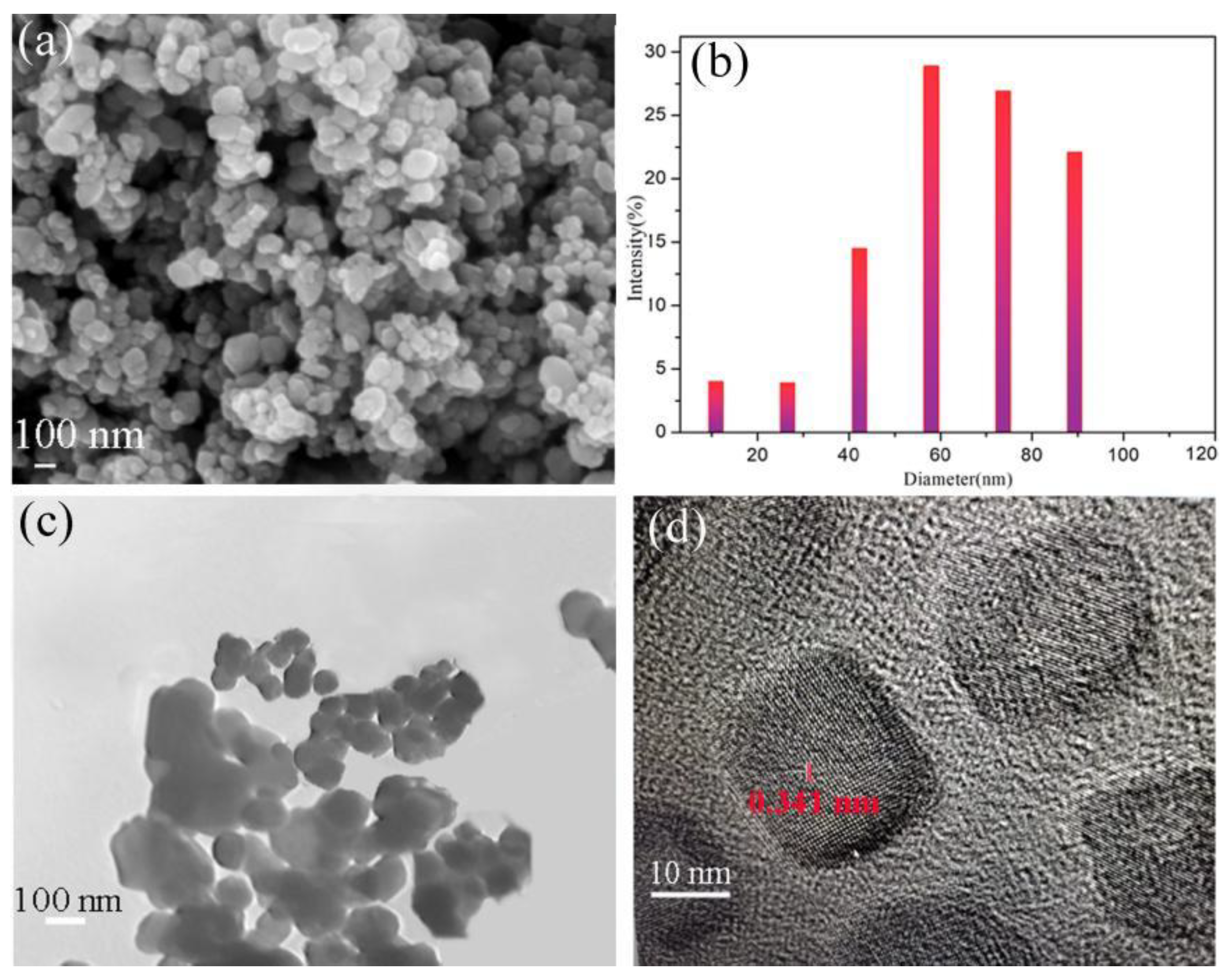
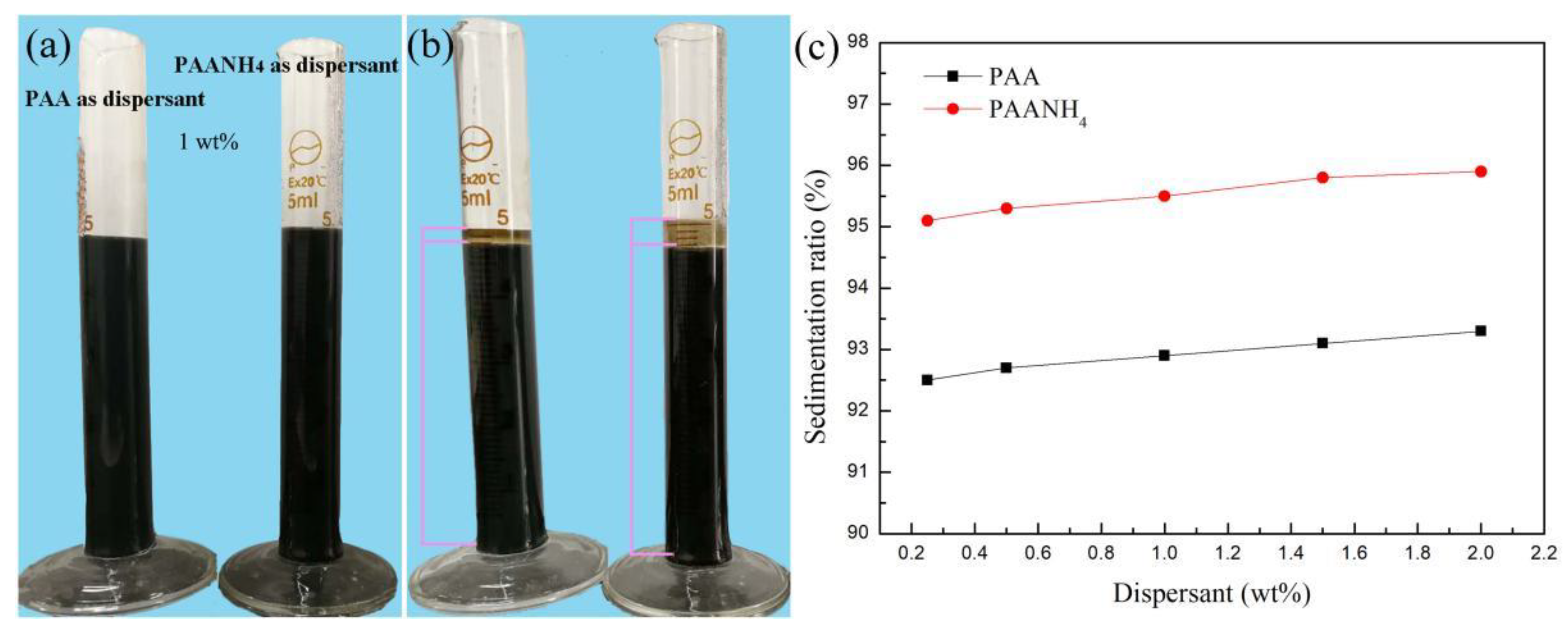
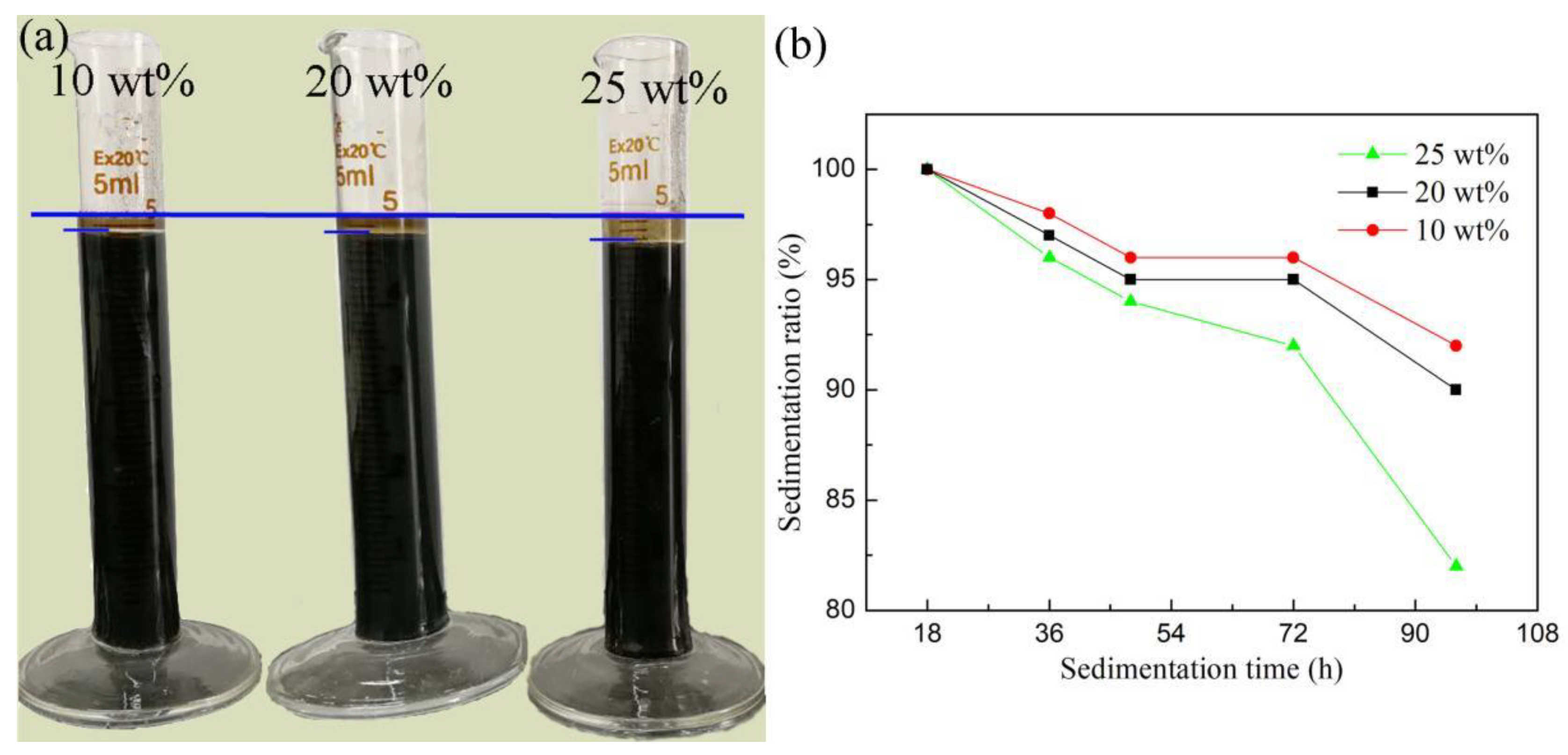
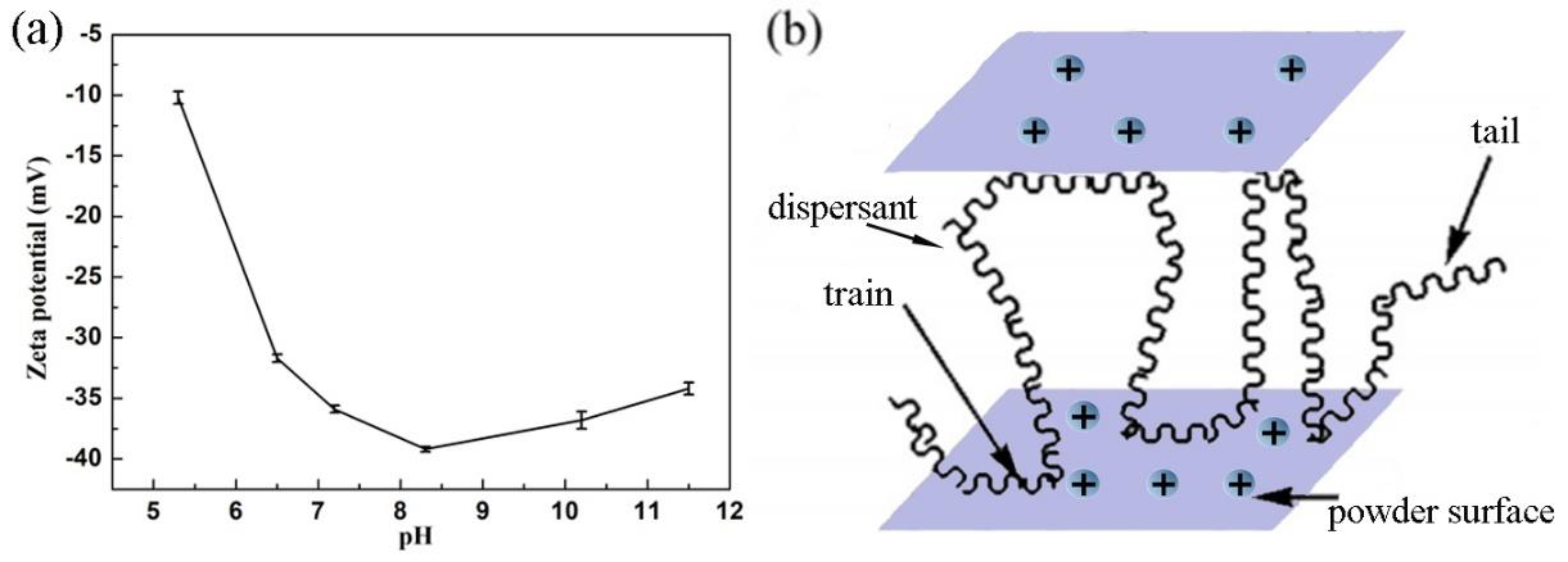
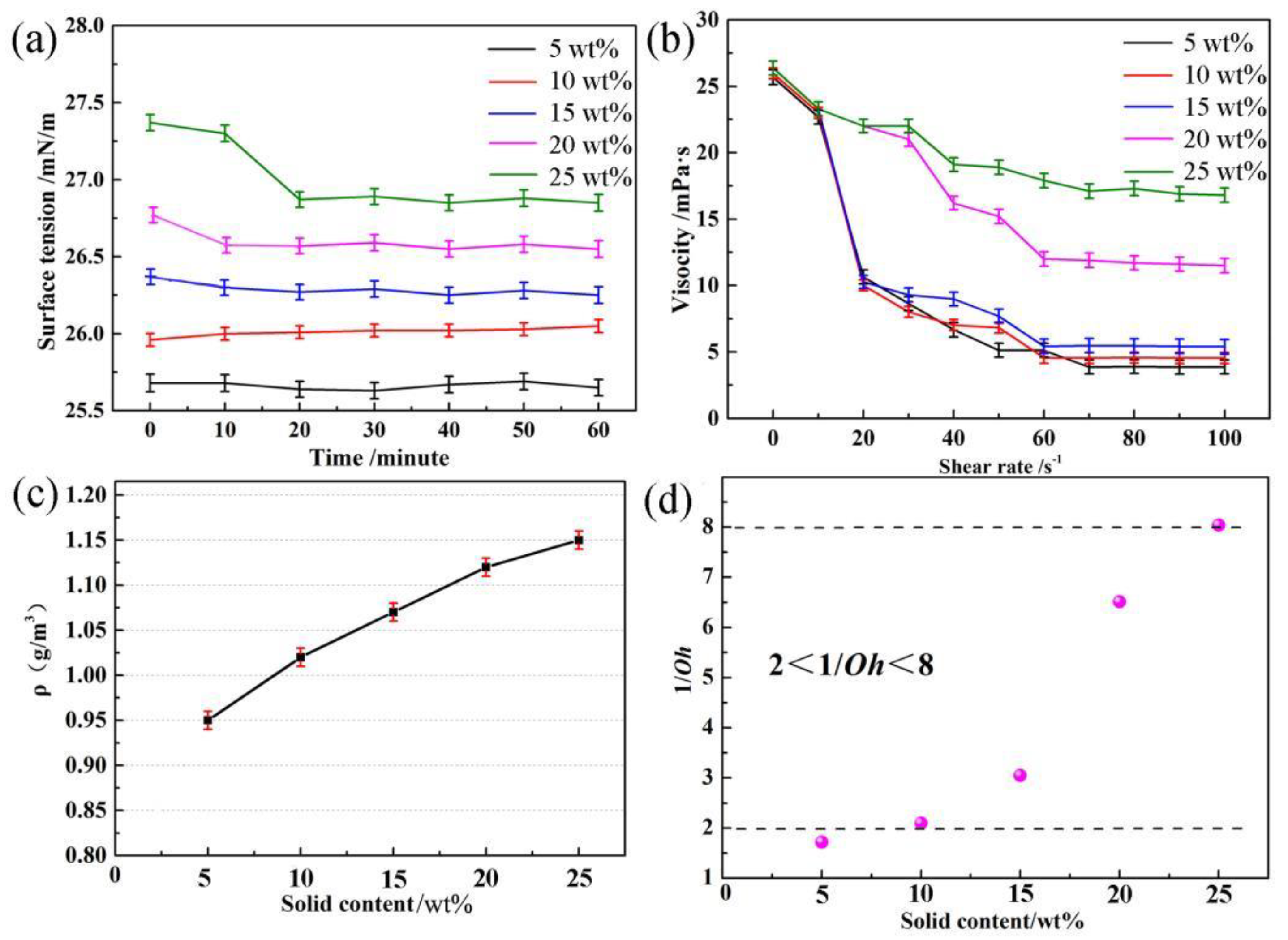
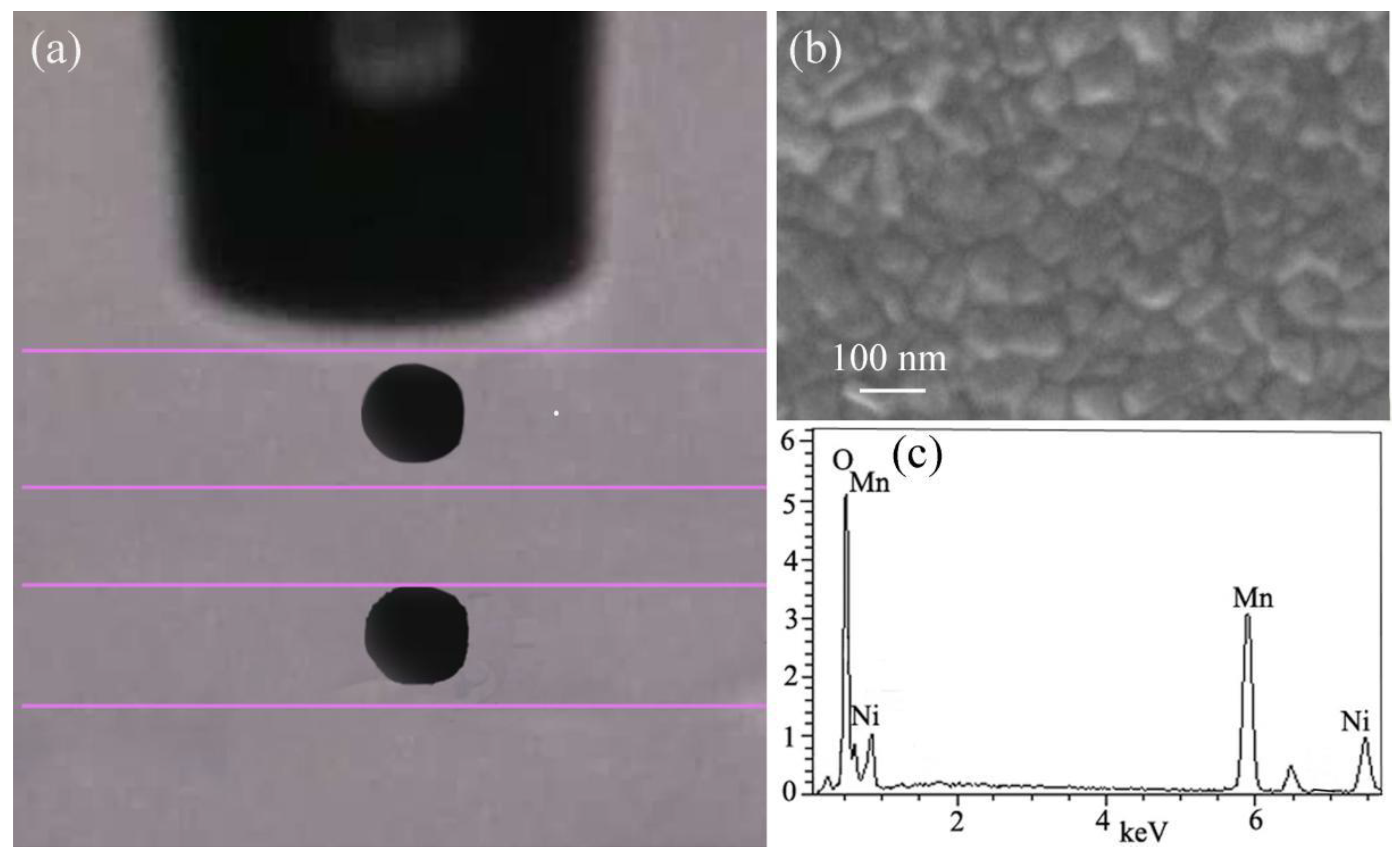
| Parameter | Pluse Voltage | Pluse Width | Delay Frequency | Frequency |
|---|---|---|---|---|
| Value | 0 V, 95 V, −20 V | 3 μs, 30 μs, 3 μs, 30 μs, 3 μs | 150 Hz | 1000 Hz |
| Composition | Ni-Mn-O Powder | Deionized Water | PAANH4 | PEG 400 |
|---|---|---|---|---|
| weight (g) | 1.0 | 3.7 | 0.05 | 0.25 |
| ratio (wt%) | 20.0 | 72.0 | 1.0 | 5.0 |
Disclaimer/Publisher’s Note: The statements, opinions and data contained in all publications are solely those of the individual author(s) and contributor(s) and not of MDPI and/or the editor(s). MDPI and/or the editor(s) disclaim responsibility for any injury to people or property resulting from any ideas, methods, instructions or products referred to in the content. |
© 2022 by the authors. Licensee MDPI, Basel, Switzerland. This article is an open access article distributed under the terms and conditions of the Creative Commons Attribution (CC BY) license (https://creativecommons.org/licenses/by/4.0/).
Share and Cite
Li, H.; Yang, L.; Li, F.; Xian, Q. Development and Characterizations of Novel Aqueous-Based Ceramic Inks for Inkjet Printing. Materials 2023, 16, 21. https://doi.org/10.3390/ma16010021
Li H, Yang L, Li F, Xian Q. Development and Characterizations of Novel Aqueous-Based Ceramic Inks for Inkjet Printing. Materials. 2023; 16(1):21. https://doi.org/10.3390/ma16010021
Chicago/Turabian StyleLi, Haibing, Linyu Yang, Feng Li, and Qinglong Xian. 2023. "Development and Characterizations of Novel Aqueous-Based Ceramic Inks for Inkjet Printing" Materials 16, no. 1: 21. https://doi.org/10.3390/ma16010021
APA StyleLi, H., Yang, L., Li, F., & Xian, Q. (2023). Development and Characterizations of Novel Aqueous-Based Ceramic Inks for Inkjet Printing. Materials, 16(1), 21. https://doi.org/10.3390/ma16010021






